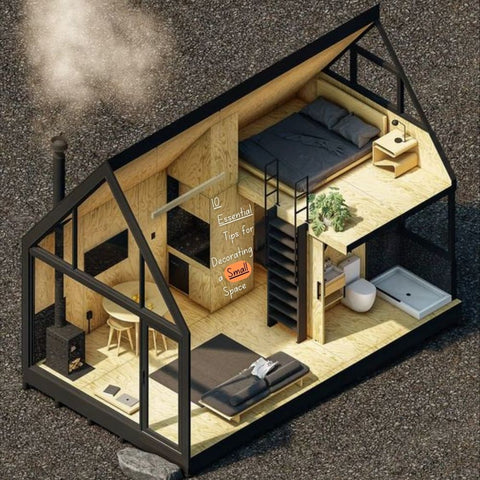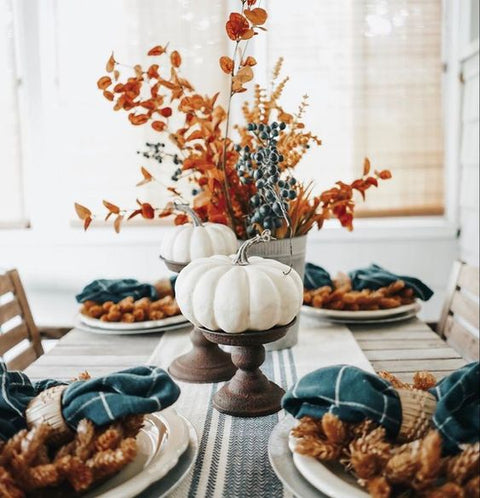6-minute read
In the beginning, it can feel like a bit of a challenge to figure out the best ways to make use of small interior space, but if you follow this guide it will be much easier, and also very rewarding!
Decorating a small apartment or small room is exciting because it forces you to think outside the box and to experiment, you might even discover new furniture layout tricks and decorating ideas that you can use to improve larger spaces too.
Decorating and furnishing a small room is a great brain-training exercise for anyone who enjoys interior design, ingenuity and puzzles, and the end result is a space that is much nicer and more enriching to live in, all because you took a little time and consideration to think creatively about using what you have in the best way possible.
What one person might see as a tiny room barely big enough to fit a bed or desk and chair in, another person will look at and think 'there are so many different things I can do with this space' (especially after reading this guide).

Step 1. Optimise Furniture layout
Choosing the best layout for your furniture is probably going to have the biggest impact on how a smaller space will feel, so that's a perfect place to start. Here are some key takeaways for arranging and choosing furniture in a small room:
- Consider the 'flow' or movement - both how you physically walk through the room and how your eyes move through the room. Arrange your furniture in a way that contributes to the movement and flow of the whole room.
- Create zones by strategically placing things like shelves, dividers, and tall house plants to divide off separate areas of the room - we'll go more into this below.
- You can also go the complete opposite of separate zones, and instead aim to maximise the space as one single area, making sure that the centre of the room feels open.
- Choose furniture that has visible legs, rather than sitting flush on the floor. This will add a sense of 'airyness' and make the whole space feel lighter and less cramped. You can also think about using some transparent furniture, like a glass coffee table, which will give the illusion of not taking up any space in the room.
Furniture with visible support legs creates a sense of openness, as it allows light & air to flow under the furniture, making the space appear less cramped.

Step 2. Make Use of Vertical Space
While floor space is usually limited in small rooms and apartments, often the ceiling is still a standard height - which means one thing: more precious space you can utilise in the room! So this next tip is to go for tall furniture like shelving, bookcases or dressers helps to add more storage without taking up any additional floor space.
- Look around the room at the vertical space with a fresh perspective in your small apartment. Often, areas above doorways are underused in almost every home. Places like these make perfect spots for storage or open shelving, or maybe a hanging vine plant like pothos.
- Also, try installing longer curtains or blinds at ceiling height (rather than hanging them from the top of the window frame), this trick works great at drawing the eyes upwards and adding a sense of scale to a smaller space.

3. Separate the Space into Areas & Zones
Rugs are really effective at making a space feel like a room. If you're going for a 'zoned' room (where you have several different zones or areas) you can use several rugs to create these separate zones within the room.
Or, if you want to go the opposite route, and maximise the full square footage of the room to make it feel more open, use one large rug that covers all or most of the floor instead of several smaller rugs. This will work especially well (at creating an open feeling) if you choose a lighter-coloured rug.
Experiment with different placements of objects in the room.
Open shelves, plants, side tables or even room-divider screens are perfect for cordoning off a part of the room without it feeling completely closed off or obstructing the room.
Remember Tip 1 (furniture layout) here too, and try to make sure that each area or zone in the room naturally 'flows' into the next. You can check for this by sitting in one zone and then get up and move to the next one - if you have to walk around several things or step over something it's probably best to rearrange things a little to connect the areas a bit more.
Note: Where it makes sense, think about adding some wheels to the bottom of furniture or objects if you're using them to divide or mark out a zone, this will make moving them around as you use the space in your daily routine so much easier.

4. Have items with many functions
When you are trying to make use of every last inch of space in a smaller space, you have to be mindful of every new addition and how much it actually contributes to the room compared with the space it occupies. This might feel a bit like a Machiavellian way of looking at furniture and decor, but in this case, needs are a must.
Furniture that is multifunctional, modular or easily storable is your best friend when choosing furniture and deciding on the layout for a small apartment. Some great examples of these are:
- Benches, ottomans and other seating with built-in storage.
- Murphy desk (one that folds down from the wall).
- Folding beds or sofa-beds.
- Nesting tables.
- Hidden storage compartments.
- Foldable chairs and extendable tables.
- Sliding barn doors.
- Shelving on wheels.
- Movable walls or half-walls.
5. Make use of the walls
While the walls are technically part of the vertical space, vertical space refers to going from the floor upwards with high furniture. The walls are, again often underutilised in home decorating, especially in smaller spaces.
There is a nice list of ideas for decorating and furnishing walls just below, but it's also worth mentioning something quickly about choosing artwork and photographs for a small interior.
- Hanging artwork or photos that look like they could be a view from a window in the room will help to extend the space out beyond the walls.
- Large artwork or photos can help to bring a sense of grandeur and actually make a small room feel bigger, while lots of smaller photos or art might make the room feel a bit cluttered - more on scale and clutter below.
As well as hanging artwork and photographs, some other great ideas for decorating or furnishing the walls in a small apartment are:
- Peg boards or wall hooks.
- Vertical gardens or wall planters.
- Wall hangings - macrame or otherwise.
- Geometric or floating shelves.
- Planted hanging baskets.
- Mirrors or reflective objects/ art.
- Wall decals - peel and stick.
- Wall-mounted desk or vanity table.
- Fairy lights and wall lighting.
- Hang a TV vertically and display different images of window frames with outside views.

6. Use Scale to Your Advantage
In general, in a smaller space you want to use smaller furniture and items - this will help with making the room or apartment feel bigger and airier than it actually is, compared with cramming a giant couch in there and calling it a day.
Pay close attention to the sizing and dimensions of larger furniture items like tables, beds, couches and chairs when shopping for your small room - especially if it's online where the sizes can sometimes be deceptive in photographs.
The exception to this guideline is with artwork, where often a larger piece can add a lot more to the space than several small ones which might lead to a cluttered feeling every time you glance at the crowded wall.

7. Use the corners
The corner of a room is usually overlooked and underused, but when space is at a premium, you need to go outside the norm, so take a second look at the corners of the room and see if there are perhaps other ways you can make better use of the space.
Some nice examples of this are:
- An armchair or beanbag for a reading nook.
- Nesting tables.
- Corner aquarium or terrarium.
- Built-in folding seating or table surfaces.
- Shelving & storage console.
- A cozy corner for you and/or your pet to hang out in.
- Record player or speaker for enjoying music or a podcast.
- Meditation or arts and crafts nook.
- Cat climbing tree or shelves.
- Cascading hanging plants.
- Make a Zen corner.

8. Choose the right colours & paint
Choose carefully when deciding on paint for your small apartment or room, lighter colours are always best. If there's a paint colour you really like but is on the darker or more saturated side, you can always mix it with some white paint to get the shade you're looking for.
There are also some nice tricks that you can do when choosing which wall to paint an accent colour. Here they are:
- For more of a spacious feeling: Paint two parallel walls.
- For low ceiling rooms: Paint one vertical thin section of a wall.
- For a more snug feeling: Paint the ceiling an accent colour.

9. Maximalise Light
Light is the source of all sense of space and mood in interior design. It sets the tone and even your perception of how big or small a room feels. Dim light can make a large room feel conjested and cramped, where bright light or several sources of light will make a small room feel bigger than it actually is.
Windows:
Try not to obstruct the windows with any furniture in your small apartment, if you want privacy or don't have the nicest view out of the window consider some sheer curtains or a stick-on window froster to still allow as much light in as possible.
Mirrors:
I like to add a mirror to any wall or section of the room that doesn't receive as much daylight to brighten it up and extend the openness of the room. You can also bounce light from the window into a darker corner of the room using a mirror on an adjacent wall to transform a dark corner into a much nicer nook in the room.
Lamps:
In the evening and night time, having several small sources of light rather than one main brighter light will have the effect of creating different zones in the room and will almost blur the boundaries of the room to make it feel more open - feeling similar to being at a campfire amongst the trees - in a safe place to camp of course. ;)
10. Minimalise clutter
Be intentional with what items are on the shelves, walls and surfaces. To a degree, less is more - and that's especially true with clutter. You know it when you see it.

11. Move things around
No matter how much you dial in, adjust or optimise a room's layout and decor, nothing is immune to the passing of time and a feeling of over-familiarity, sometimes you just need to change things up. This is often especially the case in smaller rooms or apartments.
A great time to do this is to follow along with the seasons where you are living. You don't have to change much (or anything at all if you don't feel the need), but rearranging the layout of a room can make it feel like a brand new home again. Certain room layouts and decor make more sense during certain times of the year, depending on the season and how you use and feel in the space during that time.

If nothing else, remember this:
If we were to boil it all down, when decorating a small space you are trying to:
- Maximise certain aspects and minimalise others.
- Leaning into the strengths of the space, turning some weaknesses into strengths.
- Knowing where the limitations of the room or apartment are.
Alright, take a few moments to look around your small apartment or room and think of what you would do if there were no limitations to cost or time, then sketch out or write down some of those ideas.
Now you have something to work towards you can think of realistic ways to make an attainable version of that.
If you enjoyed this guide and found it useful, definitely check out our other DIY home improvement guides below. Also check out our collection of premium wooden kitchenware and homeware now to choose your favourites for your space of any size!
Read:
- How to Make Your Home Feel New
- 1-to-Zen: Make a Zen Space Step by Step
- How to Make a Jar-Terrarium
- 16 Creative Uses for Wooden Plates
- 41 Craft Ideas for Glass Jars
Shop:






Comments (0)
There are no comments for this article. Be the first one to leave a message!